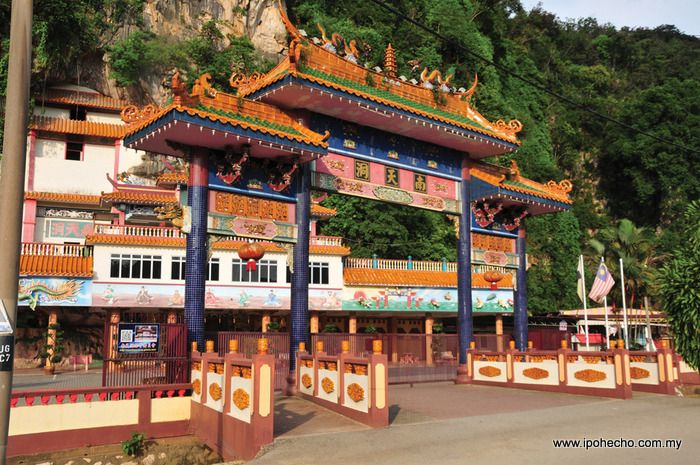Cover Story: Caves of the Kinta Valley


Cover Story
By Nantini Krishnan, Ili Aqilah & Tan Mei Kuan
Pictures by Rosli Mansor
The Kinta Valley is renowned for its Karst formations, which according to the Malaysian Karst Society, is landscape underlain by limestone which has been eroded by water through dissolution, producing various formations, including the limestone hills and caves. It is the caves that hold fascination for many and these abound, some, left alone to the birds and bats, some developed as tourist attractions, while others have been used as places of refuge and prayer. Ipoh Echo set out to explore some of these.


From places of devotion and prayer to caverns of awesome exploration and wonder
Thrangu Dharma Retreat Centre Tambun

Nestled in the lush Tambun hills away from the hustle and bustle of the city, Thrangu Dharma Retreat Centre is an oasis of peace and welcome. The centre conducts contemplative programmes, retreats and prayers under the guidance of its 38-year-old Resident Lama, Lama Sangye from Nepal who entered monkhood at the age of 15.
A 11-feet Maitreya Buddha (the Buddha of the Future) statue, the first and the only one in Malaysia, was built last year. “This statue is very precious and many people come here to practise,” the self-effacing monk who likes to read in his free time told Ipoh Echo. “The completion of this beautiful and unique statue is a very auspicious occasion as we could see a change in our cave. For example, it is full of energy. Many people come to the cave to see the Maitreya Buddha and they are all full of praise,” added Madam Lee Lai Keen, the Chairman of the retreat centre.
During the Wesak Day celebration, the temple which was built in 2006, received more than 60 visitors. “Of course we wish for more to come. Once all the statues are completed, we will have an opening ceremony and we wish for Buddha Dharma to flourish in this centre,” the 61-year-old chairman disclosed to Ipoh Echo.
Every month, the centre organises the Green Tara Puja in the first week, the 4 Arm Chenrezig Puja in the second week, the Guru Rinpoche Puja in the third week, the Medicine (Menla) Puja in the fourth week and the Amitabha Puja in the fifth week. Meanwhile, retreats are held three times a year.
In the cave, elaborate altars in the alcove are illuminated with gentle golden lights and flickering candles, providing a soothing tranquillity for the holy place. In addition, the natural limestone formations and aroma of incense lends the cave a special atmosphere.
Cave Temple Address: 7.5 miles, Jalan Tambun, Tanjung Rambutan, 31400 Ipoh, Perak. GPS: N 4° 37’ 40.8” E 101° 09’ 02.9” Contact: 05 253 1181Gua Tempurung
One of the largest and longest natural limestone caves in Peninsular Malaysia, Tempurung Cave has been operated as a tourist cave since 1997. The iconic cave contains five giant domes: Golden Flowstone Cavern, 90m, Gergasi (Giant) Cavern, 15m, Tin Mine Cavern, Alam (Universe) Cavern, 72m, and Battlefield Cavern.
This nature’s wonder at our doorstep has viewing platforms and railings to minimise inconvenience as well as illumination to highlight the cave’s majestic fairyland of shimmering crystal deposits, stalagmites, stalactites, multi-tier ponds and volcano-like rocks.
Besides its magnificent chambers and beautiful speleothems, its almost vertical walls, slippery stones and chest-level underground crystal clear river also beckons to cave enthusiasts and adrenaline junkies!
Dry tours and wet tours are available at the 1.2km long cave. GPS: N 4°24’58.4” E 101° 11’ 15.6”Operating hours: 9am-4pm

Kek Look Tong
One of the famous caves in Perak, Kek Look Tong was used as a place of worship as early as 1920. It later became an iron-mining site operated by the late Mr Chooi Ah Kee in 1960. At that time, the cave was named as Tien Hou Gong and it was renamed after the cave was handed over by Ah Kee’s son in 1982 to a non-profit, charitable organisation, the Kek Look Seah.


Kek Look Tong which translates as ‘Cave of Great Happiness’, was used by Chooi Ah Kee as a place of worship. The cave underwent needed renovation and the committee has done a good job in repairing and preserving its heritage. The natural architecture of this cave is beyond amazing. From its head-of-dragon-carp-shaped entrance, gill-like limestone formations to gallbladder-shaped hind cavern and Buddhist statues, visitors will be mesmerised and awed through the entire tour.
A visit to the garden, located at the back of the cave, will leave guests awestruck by its lush green trees and reflexology footpaths. The park is surrounded with a variety of flora such as bougainvillea and hibiscus. It is also a natural habitat for carp, turtles, lizards and monkeys.
Open for public from 7am to 7pm, Kek Look Tong is a must visit for everyone! GPS: N 4° 33’ 32.6” E 101° 07’ 46.4”

Panjang Cave
Gunung Panjang is a large limestone hill in the Kinta Valley in Tambun, Ipoh. It is about a 10-minute drive from AEON Kinta City Shopping Mall. Gunung Panjang is best known for the neolithic art believed to be painted by the ancestors of the Orang Asli and believed to be 5000 years old. These rock paintings depict the life of the early dwellers and many of these beautiful Neolithic murals are still visible, demonstrating that men lived in the area during that period. The paintings 20-30 feet above ground are likely to be genuine, but the alphabetic and modern paintings at ground level are merely the work of vandals. Visitors to Panjang Cave will also be thrilled by the inhabitants around the area which include troops of monkeys, horses, goats as well as several types of birds. To get there use GPS coordinates N 4° 36’ 25.8” E 101° 07’ 48” or follow the road sign to Tambun until you see the Caltex Petrol Station on your right. Next to the petrol station, there is a small lane that leads to a little polo field. Cut through the field towards the base of the limestone massif and you will see the signboard ‘Lukisan PRA Sejarah Gua Tambun’ just around the corner.
Open to the public and better to go in the daytime.






Kandu Eco Adventure
Gua Kandu is a cave system in the vicinity of Gopeng in the Kinta Valley. It is located about half an hour from Gua Tempurung. Gua Kandu was used as a base by Japanese soldiers during World War Two and later, it was taken over by Communists as their hideout during the Emergency. Evidence of these former cave dwellers can still be seen in some sections of Gua Kandu. The caving exploration which takes about two hours to complete involves rock scaling and rock sliding. There are three sections to Kandu Cave with four entrances. The most popular and frequently used one is at the second section of the cave. Gua Kandu was formed 500 million years ago and interesting rock formations, stalagmites and even patterns on the wall can be seen as you go from one chamber to another. The cave is located 1.5km from the Gopeng toll exit.
Address: Lot 9176, Gunung Mesah Hulu, Jalan Jahang, 31600 Gopeng, Perak. GPS: N 4° 26’ 56.4” E 101° 10’ 27.2” Contact: 019 510 1253 (Marzuki) or 019 480 1253 (Norhayati)





Sam Poh Tong
Discovered in 1912, Sam Poh Tong is a natural limestone hill that is used as a place for Buddhist worship. It has become the most famous cave in Ipoh as it was said to be the biggest cave temple in the country and easily accessible as it is situated along Gopeng Road.
According to legend, in 1890, a monk from China visited the cave and decided to meditate for 20 years. To this day, monks and nuns who dedicated their life to Buddhism, reside here. Guests who visit this cave will get to discover statues of Buddha in various forms, both man-made and carved from natural materials.
Aside from Buddha statues, visitors will be entranced with the colourful and vibrant mural paintings and other statues located around the caves. Tourists should pay a visit to Sam Poh Tong’s legendary tortoise pond and yes, you are allowed to feed the friendly tortoises with water spinach (kangkung) sold at the entrance.
The peak season for Sam Poh Tong is during Wesak Day and other Buddhist festivals. Be sure to plan your trip to this beautiful limestone cave beforehand. And while there, finish your visit with a meal at their vegetarian restaurant near the entrance from the road.
GPS: N 4° 33’ 51.6” E 101° 06’ 56.0”






